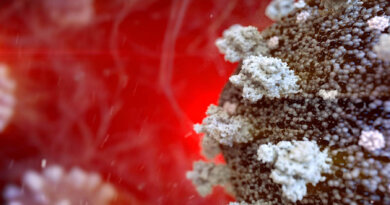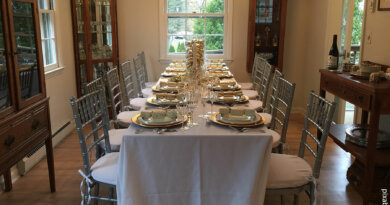A statewide survey of California’s bumblebees hopes to help conserve them : NPR
AILSA CHANG, HOST:
You know what? I have always been proud to say that I have never been stung by a bee. But just a few days ago, I was worried that streak was coming to an end.
Is today going to be the day?
LEIF RICHARDSON: Today’s not going to be your day.
CHANG: Please do not let this be the day.
RICHARDSON: If it is, I have an EpiPen should things get out of hand.
CHANG: OK. Alright.
RICHARDSON: But no…
CHANG: I know how to use it.
RICHARDSON: …We’re not going to get stung today.
CHANG: OK.
RICHARDSON: Yeah.
CHANG: Promises, promises.
I’m talking to Leif Richardson there. He’s a conservation biologist who leads a project powered by hundreds of volunteers. It’s called the California Bumble Bee Atlas. It’s sort of like a census for bumblebees, a tool to help guide their conservation. I tagged along with Leif to see how one of these sampling expeditions works, which meant meeting up in the mountains of Malibu.
I’ve never seen insect nets like this except in the cartoons (laughter).
We got our bee nets and a small cooler because we are literally going to chill out the bees we find. It’s a harmless way to calm them down long enough to photograph and study them. And today, Leif has his eye on a particular species of bumblebee – one that he hopes will be the catch of the day.
RICHARDSON: I want to show you today Crotch’s bumblebee – bombus crotchii. This is a big, short-haired very beautiful bee that is a denizen of the warmer parts of California. We’re likely to see it today…
CHANG: Oh.
RICHARDSON: …But it is in decline. So it’s currently protected by state law, and it’s under consideration for listing as a state endangered species.
CHANG: So we set off. We’re walking about a half-mile down the trail.
RICHARDSON: So this is poison oak. I just wanted to…
CHANG: Oh, thank you, Leif.
RICHARDSON: …Make sure that you…
CHANG: And we arrive at a field bursting with golden deerweed and purple sage. Leif says this is a bumblebee buffet, but he warns us to slow down.
RICHARDSON: Oh, s***.
CHANG: What…
RICHARDSON: Rattlesnake.
CHANG: Really?
RICHARDSON: (Laughter).
CHANG: Wait. Where?
RICHARDSON: Right there. Right there.
CHANG: I don’t even…
RICHARDSON: We’re really close to it.
CHANG: Oh, my God.
RICHARDSON: Let’s look behind you…
CHANG: It’s huge.
RICHARDSON: …And then maybe take a step back.
CHANG: Oh, my God.
It is a fat rattlesnake perfectly camouflaged in the brush. I would have totally missed it – probably would have stepped on it. So we decide to just stay on the trail where we can see our feet. And soon enough, it’s time to catch my first bumblebee of the day.
RICHARDSON: …Like that? See the – where the bee is? She’s just below the canopy top.
CHANG: Wait. Wait.
RICHARDSON: Right…
CHANG: Show me the bee.
RICHARDSON: …There.
CHANG: Oh.
RICHARDSON: Ailsa, do you want to catch that?
CHANG: I want to. OK, here’s my…
Leif tells me to pinch the tip of the net and hold it upside down. Then I slowly lower it over the flower where the bee is foraging.
RICHARDSON: Lower it slowly over the bee.
CHANG: Make a little, like, seven dwarfs hat. OK. And then, OK, where did the bee go? Oh, there it is.
RICHARDSON: Right there.
CHANG: OK.
RICHARDSON: So…
CHANG: And I’m just going to go like this…
RICHARDSON: And right down on the top…
CHANG: …Boom.
RICHARDSON: …And then keep going down.
CHANG: OK, is this a girl or boy?
RICHARDSON: So…
CHANG: Oh.
RICHARDSON: …I’m going to reserve judgment till I…
CHANG: OK, wait.
RICHARDSON: …Get a better…
CHANG: This is when Leif tells me I have to put my bare hand up inside the net with the bee still in there to trap it in a tiny vial.
Oh, my God. I got it. I got it. I got it. I got a bumblebee. OK.
RICHARDSON: You did it. Let’s take it out of the net.
CHANG: OK.
RICHARDSON: We’ll find out.
CHANG: OK.
(LAUGHTER)
CHANG: Behold.
UNIDENTIFIED PERSON #1: Oh, my goodness.
RICHARDSON: Ailsa’s first bumblebee.
UNIDENTIFIED PERSON #2: You want to get a nice pic when you…
CHANG: Leif takes a closer look and determines this is a male bumblebee, which means it doesn’t have a stinger. So he reaches into the vial, pinches the bee with his fingers and offers it to me.
Oh, my God. Oh, my God.
RICHARDSON: If you feel him squirming away, squeeze a little harder.
CHANG: I’m holding a bee with my bare fingertips. Oh, he’s squirming. I can feel his little legs scraping against my fingers.
And the fact that there are male bees out here tells Leif that the coveted queen bees must be around here, too. And remember; at this point, we’re also still keeping our eyes peeled for that one species that Leif had mentioned – the bombus crotchii. And then boom, all of a sudden, we find a double whammy.
Oh, my God.
UNIDENTIFIED PERSON #1: Whoa.
UNIDENTIFIED PERSON #2: Whoa.
CHANG: That’s huge. What is that – queen?
RICHARDSON: This is a queen of Crotch’s bumblebee.
CHANG: That’s…
A queen of the very species that we were looking for. And she was at least two to three times bigger than any other bee we saw that day. And, you know, the excitement – it didn’t even end there because we spin around, and I see my editor, Christopher Intagliata, looking down in sheer horror.
Oh, my God.
UNIDENTIFIED PERSON #1: Whoa.
CHANG: Oh, my God. Oh, my God.
RICHARDSON: What? Whoa.
CHANG: Oh, my God.
UNIDENTIFIED PERSON #2: What is it?
CHRISTOPHER INTAGLIATA, BYLINE: [Expletive].
CHANG: Christopher is covered with something…
When he realizes his legs are covered with hundreds of giant black ants.
What are those?
INTAGLIATA: [Expletive]. [Expletive]. [Expletive].
UNIDENTIFIED PERSON #1: OK. OK.
RICHARDSON: Don’t worry.
CHANG: We frantically brush him off, hike up the trail a bit to get away from the ants’ nest, and Christopher recovers.
UNIDENTIFIED PERSON #1: Does anything sting, Christopher?
INTAGLIATA: No, I think I’m mostly good.
CHANG: Meanwhile, Leif puts the queen bee on ice in the cooler. Remember her? And I asked Leif what gathering all of this bumblebee data up and down the state of California will teach people.
RICHARDSON: We want to let people know what the status of bees is. Are there as many species now as there used to be? Are they all distributed in the same geographic ranges as they used to be, or have they shifted their ranges because of climate change or habitat loss or conversion or something like this? And so this information that our volunteers are collecting is the information that is used to make conservation planning decisions.
CHANG: So ultimately, why should we care whether some of these species of bumblebees are disappearing?
RICHARDSON: I think we should care because there’s intrinsic value to these native animals that occur here and have been here co-evolving with these plants for millennia. However, beyond that, bees are functionally very important. They’re pollinators of wild plants, but also these wild bees are really important pollinators of crops. So these wild bees are tremendously important to maintenance of healthy ecosystems, which human beings depend on, and to the human food supply, which we obviously depend on. So we’ve got both utilitarian and kind of intrinsic reasons to conserve bees.
CHANG: One of the things that I have loved about today is we have talked about all the ways that bees are misunderstood animals because I’ve always been that person when I see a bee buzzing around me, I’m like, ew, get away from me, please, get away. But I held my first bee today. I caught my first few bees today. I guess if you could speak to all those people out there who have decided they do not like bees, what do you think is most misunderstood about these animals?
RICHARDSON: I guess it’s that they’re considered to be potentially dangerous, stinging, venomous insects. They are all of those things. But there is so much more about the way these animals live. They have this rich ecological life history. They have interesting mating biology. I should mention another one is social biology. The biology of the nest is absolutely fascinating, and it gives us a model for understanding social behavior in other bees and also other insects and vertebrates like us. There’s a ton of interesting things about bees that – I think if you look beyond the hypothetical dangers of being stung by one – that they’re really interesting animals.
CHANG: True. Even I can look past the stinger because here I am asking Leif to open the cooler now so I can touch the chilled-out queen bee.
Queen bee.
RICHARDSON: Queen bee.
CHANG: Sleepy queen. Oh. Oh, not so sleepy. Look at her. She’s aflutter.
As I stroke the queen’s back, she raises up her leg, which Leif says is a sign that she’s not too happy.
She’s giving me the high five…
RICHARDSON: Yeah.
CHANG: …Which is really the middle finger.
RICHARDSON: Yeah (laughter), that’s right. It’s the middle leg.
CHANG: She mad.
RICHARDSON: She doesn’t like it, but she can’t do much about it.
CHANG: But from the looks of her twitching wings, she’s warm enough to take off now and find her way home.
OK.
RICHARDSON: There she goes. There she goes.
INTAGLIATA: Back to that spot?
CHANG: Yeah.
RICHARDSON: Yeah.
CHANG: Wow.
RICHARDSON: So they’re really good at using landscape features to find their way in mountains.
CHANG: She’ll find her way, right?
RICHARDSON: Yeah.
CHANG: OK.
And so the queen journeyed back home unharmed, and thankfully, so did we.
It’s tight quarters in those vials.
(SOUNDBITE OF MUSIC)
Copyright © 2023 NPR. All rights reserved. Visit our website terms of use and permissions pages at www.npr.org for further information.
NPR transcripts are created on a rush deadline by an NPR contractor. This text may not be in its final form and may be updated or revised in the future. Accuracy and availability may vary. The authoritative record of NPR’s programming is the audio record.




